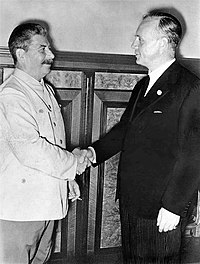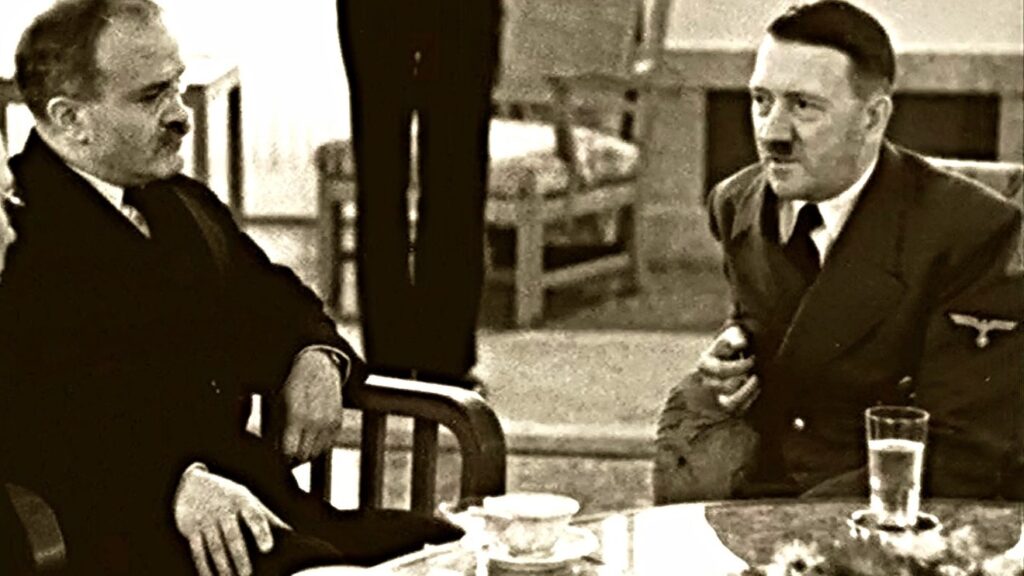Since Vladimir Putin ordered Russian troops to invade Ukraine beginning on February 24, 2022, calls of Russian soldiers phoning home that the Ukrainians have intercepted have proliferated on youtube. In those calls Russian soldiers often refer to Ukrainian soldiers as what sounds like “bandits.” The word these Russian soldiers are actually using is Banderites.
One of the expressed reasons for Russia’s invasion of Ukraine is the stated desire to de-Nazify Ukraine. Understanding what a Banderite is and the history of the Soviet Union’s early collaboration with Germany prior to and at the beginning of World War II is helpful in understanding the twisted logic behind Putin’s justification for his invasion.
A Banderite is a Ukrainian follower of Stepan Bandera. Bandera was born in Galicia to a Greek-Orthodox family in 1909. When Bandera was a young boy Galicia became part of Poland, but it had a sizable Ukrainian minority. Bandera identified as Ukrainian and became a Ukrainian nationalist.

In 1934 Bandera was involved in the assassination of Poland’s Minister of the Interior and was subsequently imprisoned. In 1939, as Nazi Germany invaded Poland from the west and the Soviet Union invaded from the east, Bandera was freed from prison and was for a time a Nazi collaborator.
After Nazi Germany attacked the Soviet Union Bandera declared Ukrainian independence and vowed to work with Nazi Germany to fight against the Soviet Union. At the time Ukraine was a part of the Soviet Union. The Nazis accepted neither Ukrainian independence nor Bandera’s offer of help and sent Bandera to a concentration camp.
Only when the Soviet forces reversed the Nazi’s early successes did the Nazi’s release Bandera in hopes he would help stem Soviet military advances. At the end of World War II, the Soviet Union not only reasserted complete control over Ukraine but came to dominate Poland as well as most of the rest of central and eastern Europe.
After the war, Bandera fled to West Germany where he would live until he was assassinated by the KGB, the Soviet Committee for State Security, in 1959. Vladimir Putin would join the same KGB in 1975 and was stationed in East Germany when the Berlin Wall fell in 1989.
Because of Bandera’s collaboration with Nazi Germany and anti-Polish and anti-Jewish views and actions, Bandera is reviled by most Poles and most Jews. Because of Bandera’s activities trying to help Ukraine gain independence from the Russian dominated Soviet Union, Bandera is reviled by many Russians, including Vladimir Putin. Because of Bandera’s fight to secure Ukrainian independence from Poland and Russia, some in Ukraine have a favorable view of Bandera and even see him as a national hero.
So Stepan Bandera was a Nazi collaborator. But what country collaborated the most with Nazi Germany?
At the end of World War I in 1919, Germany’s military had taken a huge blow from not only the war to end all wars, but also by the punitive Treaty of Versailles which greatly constrained the ability of the German military to rebuild and rearm. The Soviet Union’s military was also in disarray after World War 1, two revolutions, and a civil war following the abdication of the last Tsar of Imperial Russia and the coming to power in Russia of the Bolsheviks.
Only a few years later, Germany and the Soviet Union entered into secret negotiations to cooperate in developing and growing the military of each. The collaboration of the two powers allowed Germany to clandestinely rebuild their military at a number of facilities in the Soviet Union, far from the prying eyes of France, England, and others. Joint research on new weapons and techniques, as well as cooperative military training, allowed both Germany and the Soviet Union to rebuild their devastated military capabilities in a way neither could on their own.
This cooperation between Germany and the Soviet Union largely ended with the rise to power of Adolph Hitler and his National Socialists in 1933, but only for a time. On August 23, 1939, Nazi Germany and the Russian dominated Soviet Union completed lengthy negotiations and signed a non-aggression agreement. This agreement was commonly known as the Molotov-Ribbentrop Pact, or less commonly as the Hitler-Stalin Pact or Germany-Soviet Union Pact. The Pact included secret protocols for the dismemberment of Poland and separate zones of influence for Nazi Germany and the Marxist Soviet Union.

Nazi Germany’s Minister of Foreign Affairs Joachim von Ribbentrop

Nazi Germany’s Dictator Adolph Hitler
The virulently anti-Semitic nature of the Nazi regime was already well known at the time the Pact was signed. Hitler’s manifesto, Mein Kampf, or My Struggle, replete with anti-Semitic and anti-Slavic rants, was published over ten years earlier. The Nazis had already put into force many other Anti-Jewish measures. Kristallnacht, or Night of Broken Glass, a pogrom against Jewish businesses, homes, and synagogues within Germany, had taken place not even a year earlier.
A few weeks before the Soviet Union signed the pact with Hitler, Soviet Dictator Joseph Stalin had replaced his Polish born Jewish foreign minister, Maxim Litvinov, with the man who would give his name to the pact, the ever-loyal Vyacheslav Molotov. Stalin also had killed many of the prominent Jewish “Old Bolsheviks” he had languishing in Soviet prisons, such as Grigori Zinoviev, Lev Kamenev, and Karl Radek. Assassination attempts had already been made on Stalin’s orders against the most prominent Jewish Marxist Revolutionary, Leon Trotsky, but those attempts were not successful until a year after the signing of the pact when Trotsky was killed by an ice axe to the head while in exile in Mexico City.
As anticipated by the Molotov-Ribbentrop Pact, on September 1, 1939, Nazi Germany invaded Poland from the west. In concert with the Nazis, the Soviet Union invaded Poland from the east on September 15, 1939. By early October the Polish military in Poland had been completely defeated although some units escaped to Romania and elsewhere. Nazi Germany and the Soviet Union then, again as laid out in the Molotov-Ribbentrop Pact, cooperated in dividing Polish territory between themselves. Poland was no more.
For the next 21 months, Nazi Germany’s most powerful ally was the Soviet Union
In those 21 months, Nazi Germany wreaked havoc on much of the rest of Europe. In the spring of 1940, with their Eastern Front secure due to the Pact with the Soviet Union, Nazi Germany invaded Denmark, Norway, France, Belgium, Luxemburg, and the Netherlands. In a few short months, all those nations surrendered to the Nazis, freeing Hitler up to begin the Battle of Britain, a series of massive German bombing raids on English cities, including London. With the fall of the Netherlands, the teenage diarist Anne Frank, who had fled from her native Germany with her family in 1934 due to Nazi persecution and perhaps the best-known Jewish victim of the Holocaust, was again within Nazi held territory. In the spring of 1941, Greece and Yugoslavia in the south also surrendered to Nazi Germany.
Not to be outdone by Hitler’s conquests in Western and Southern Europe, Stalin had his Soviet forces attack Finland in November of 1939 and then invade and capture Lithuania, Latvia, Estonia, and parts of Romania in the summer of 1940 in Eastern Europe. All was going well and according to the secret protocols of the Molotov-Ribbentrop Pact in the eyes of Stalin and the Soviet Union, for those first 21 months.
That is until June 22, 1941. On that day, to the utter surprise and consternation of Stalin, Hitler broke his non-aggression pact with Stalin and Germany began a massive attack upon the Soviet Union. Then and only then did the Soviet Union declare war against Germany and begin to fight the Nazis. Only after Germany attacked first and after years of Soviet collaboration with Germany and working in concert with Hitler did Stalin and the Soviet Union decide that Nazi Germany needed to be defeated.
Upon the German forces attacking the Soviet Union, Stalin pursued a “scorched earth policy.” Soviet forces retreated east, taking everything that could be moved, including whole factories, and destroying what could not be moved. In Stalin’s own words:
“In case of forced retreat of Red Army units, all rolling stock must be evacuated, the enemy must not be left a single engine, a single railway truck, not a single pound of grain or gallon of fuel. Collective farmers must drive off all their cattle and turn over their grain to the safe keeping of the state authorities, for transportation to the [east]. If valuable property that cannot be withdrawn, must be destroyed without fail.”
A look of the map shows that the scorched earth of the Soviet Union and lands Stalin surrendered to the Nazis mostly coincided with the Soviet Republics of Belorussia and Ukraine. After those areas and their citizens were sacrificed, Stalin defended to the end the ethnic Russian cities of Leningrad, Stalingrad, and Moscow.
Despite the untold human carnage caused by World War I and World War II, Putin claimed the collapse of the Soviet Union in 1991 was the “greatest geopolitical catastrophe” of the 20th century. The loss, though, was not a loss for all of the peoples of the former Soviet Union, such as the Ukrainians, but specifically for the Russians. The breakup of the Soviet Union “was a disintegration of historical Russia under the name of the Soviet Union.” Showing how the Soviet Union continued the Imperial tradition of the Tsarist Russian Empire, Putin said Russia “turned into a completely different country. And what had been built up over 1,000 years was largely lost.”
The Russian leadership, during World War II and now, was never about defeating Nazism or Neo-Nazism. Stalin and the Soviet Union collaborated with Hitler and Nazi Germany until Hitler decided to end the collaboration, not Stalin. Russian leaders, then and now, are only about maintaining their own power, nothing more.
Whatever may be said about Stepan Bandera and the so called Banderites, Adolph Hitler and Nazi Germany never had a more willing and greater collaborator than Joseph Stalin and the Russian dominated Soviet Union.